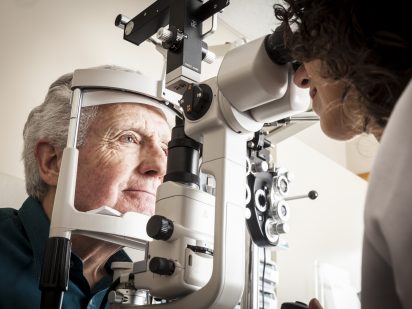Macular degeneration is an ophthalmological condition in which there is blurred or no vision in the center of the visual field.
Also known as age-related macular degeneration (AMD), macular degeneration occurs when the retina becomes damaged, causing the loss of central vision. In the meantime, peripheral vision, which is vision from all sides of the eye, remains normal.
It is estimated, 15 million Americans have AMD. According to the National Eye Institute, the risk of AMD increases with age, with the disease affecting more than 14 percent of white Americans 80 years of age and older. AMD is the leading cause of vision loss and blindness among older Americans (65 years and older).
There are two types of AMD:
- Dry Age-Related Macular Degeneration, which is quite common. Among 80 percent of people who have AMD have this form. With dry AMD, part of the macula (the center of the retina) get thinner with age and drusen (tiny clumps of protein) grows. Central vision is slowly lost.
- Wet Age-Related Macular Degeneration, which is less common but more serious. With wet AMD, new, abnormal blood vessels grow under the retina. These vessels may leak blood or other fluid, leading to scarring of the macula. Vision is lost faster with wet AMD than dry AMD.
Other than age, risk factors for AMD include a positive family history, cigarette smoking, hyperopia, light iris color, hypertension, hypercholesterolemia, female gender, and cardiovascular disease, the American Academy of Ophthalmology said on their website.
According to the American Macular Degeneration Foundation, AMD is typically discovered during an annual dilated eye exam. The first signs of AMD include the presence of drusen and pigment changes in the macula. Standard screening tests include the visual acuity exam, the common letter chart often seen in a doctor’s office, as well as the Amsler grid, which looks like graph paper and is used to check whether the lines look wavy or distorted or if areas of the visual field are missing.
Once AMD is diagnosed, treatment may be available depending on the type of AMD. Dry AMD cannot be treated, although the AAO noted that a combination of nutritional supplements can help slow down the effects of dry AMD. (An ophthalmologist can suggest if vitamin and minerals are recommended for dry AMD). To help treat wet AMD, medications called anti-VEGF drugs can help reduce the number of abnormal blood vessels in the retina, as well as helping to slow any leaking from blood vessels. Laser surgery can also be used to treat some types of wet AMD. Ophthalmologists can advise on the best way to treat AMD.
“The American Academy of Ophthalmology recommends that all individuals 65 years and older receive an eye examination every one to two years, even in the absence of symptoms,” said David Jacobs, MD, an ophthalmologist and vitreoretinal surgeon with Trinity Health. “The most important thing you can do to help prevent AMD is to avoid smoking tobacco and make sure blood pressure and cholesterol are well controlled.”
Trinity Regional Eyecare has three locations: Trinity Regional Eyecare – Minot Center, Trinity Regional Eyecare – Western Dakota, and Trinity Regional Eyecare – Devils Lake.

